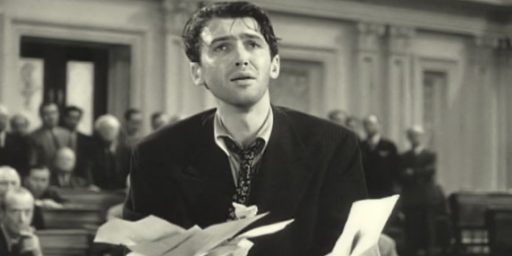Confirming Judges: The Constitutional Option
Law professors Michael B. Rappaport and John C. McGinnis argue that calling the plan to end filibusters for judges “the nuclear option” is misleading because it ignores the history of the filibuster itself.
The existing filibuster rule was enacted at the beginning of the congressional session in 1975. At that time, Sen. Walter Mondale, D-Minn., and James Pearson, R-Kan., proposed to change the old filibuster rule to permit 60 senators, rather than two-thirds of those voting, to end debate. When this proposal was filibustered, they made a motion that debate on the amendment be ended by a mere majority. Although a senator objected that the Senate rules allowed debate to be terminated only with the approval of two-thirds of the Senate, a majority of the Senate rejected this objection. In the end, the Senate reached a compromise which enacted the present filibuster rule with its 60-vote cloture requirement, but reversed the ruling that allowed a majority to end debate on an amendment to the rules.
Thus, majority amendment of the Senate rule is not something new, but was a necessary step to enacting the existing filibuster rule, which otherwise would have been defeated by a filibuster. Moreover, liberal Democrats like Walter Mondale, D-Minn., were among the principal architects of the change. And this majority amendment was anything but nuclear, since it neither destabilized the Senate nor eliminated the filibuster. Instead, the amendment caused the Senate to negotiate a compromise that has lasted for a generation.
For some other insights on the history of the filibuster, especially Sen. Robert Byrd’s role in it, see Steven Taylor’s series at PoliBlog.
Rappaport and McGinnis add an interesting caveat, though:
Of course, the Senate majority’s undoubted power to change the filibuster rule does not mean that doing so would be good policy. If modern judges feel free to amend the Constitution in the guise of interpreting it, there is a strong argument that an express supermajority confirmation rule might be beneficial. After all, through its express amendment process the Constitution requires a stringent supermajority rule before politicians can establish new norms that will bind future generations. If judging has become just politics by other means, it does seem strange to permit justices confirmed by a mere majority to start imposing their values on the rest of us.
(I should note that they then disclaim this with two paragraphs saying that, in the Republican view, judges shouldn’t act that way. Since they do, however, it seems a moot point.)
There’s something to be said for this. Members of the Supreme Court are for all practical purposes a sitting Constitutional Convention. That said, however, the courts generally follow the election returns, if slowly. Having the president, the only official who can claim a national mandate, appoint members to the Court strikes me as more representative of the current will of the people than some mushy compromise candidates who would be able to get 2/3 confirmation in the Senate.






A “compromise” candidate for the Court much more likely be someone like the character James Wilson in 1776 than, say, a John Adams or Ben Franklin.
(And I specify the character in the movie/play because script took considerable liberties with second-tier characters like Wilson, though all were based on real delegates.)
This brings me back to the question that keeps running through my mind, but I don’t have the education, wisdom or experience to answer it: How do we get judges, starting with Supreme Court justices, back to interpreting law instead of legislating morality?
Electrified robes?
If you don’t like “nuclear option” call it “ending the filibuster.” “Constitutional option” makes me want to puke–the Constitution does NOT forbid the filibuster of judges, as Rappaport and McGinnis themselves acknowledge:
“The first view – advocated most recently by Senate majority leader Bill Frist, R-Tenn. – is that filibustering judges is simply unconstitutional. But the Constitution expressly gives the Senate the right to fashion its own rules of procedure and nowhere requires application of majority rule to confirmations.”
(I don’t know who’s responsible for the headline, but generally it’s an editor, not the writer of a piece.)
It’s not unconstitutional to end the filibuster either, of course.